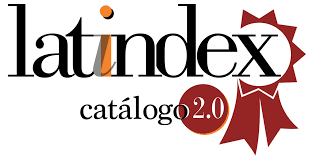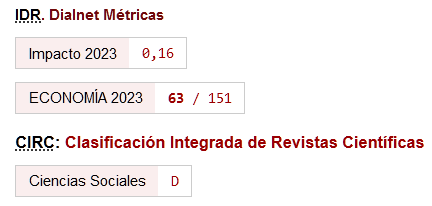El modelo de objetivos de inflación y el efecto pass-through en América Latina
Keywords:
pass-through effect, inflation targeting, Latin AmericaAbstract
The inflation targeting model has been consolidated as the new monetary policy paradigm (Perrotini Hernández, 2007a) in Central Banking and for the Latin American economies. Nevertheless, several studies have stressed that the inflation targeting model is particularly inadequate in emerging economies since it precludes the problems stemming from structural inflation, emphasizing on the importance that the exchange rate pass-through to domestic prices continues to perform in this model. Following this idea, the current paper tries to present some theoretical and empirical features that aim to cast doubt upon the success attributed to the inflation targeting model as regards the reduction of the pass-through effect in Latin American countries. This turns out to be relevant not only because the high pass-through has been one of the foremost problems that historically undermined the economic growth in Latin America, but also because a better understanding of this phenomenon might provide new insights regarding the inflationary episodes and the distributive income processes in late-industrializing economies.
Downloads
References
Ampudia, Nora (2010): "Traspaso del tipo de cambio en el proceso de formación de precios y distribución del ingreso" en Guadalupe Mántey y Teresa López (eds.) Política monetaria con elevado traspaso del tipo de cambio, La experiencia mexicana con metas de inflación, México: FES-UNAM, DGAPA y Plaza y Valdés, pp. 25-55.
_____________ (2011): "Política monetaria no convencional, traspaso inflacionario e impactos en la distribución factorial del ingreso", Economía UNAM Vol. 8 No. 22, pp. 37-53.
Angeriz, Alvaro y Arestis, Phillip (2009): "Objetivo de inflación: evaluación de la evidencia", Investigación Económica Vol. 68 No. Especial, pp. 21-46. https://doi.org/10.22201/fe.01851667p.2009.0.16686
Arestis, Phillip y Sawyer, Malcolm (2003): "Inflation targeting: a critical appraisal", The Levy Economics Institute Working Paper No. 388. https://doi.org/10.2139/ssrn.447761
Arestis, Phillip, De Paula, Luis y Ferrari-Filho, Fernando (2008): "Inflation targeting in Brasil", The Levy Economics Institute Working Paper No. 544.
Arestis, Phillip y Milberg, William (1993-1994). "Degree of monopoly, pricing, and flexible exchange rates", Journal of Post Keynesian Economics Vol.16 No. 2, pp. 167-188. https://doi.org/10.1080/01603477.1993.11489976
Ball, L. (1998): "Policy rules for open economies", Reserve Bank of Australia Research Discussion Paper No. 9806. https://doi.org/10.3386/w6760
Baqueiro, Armando, Díaz de León, Alejandro y Torres, Alberto (2003): "¿Temor a la flotación o a la inflación? La importancia del 'traspaso ́ del tipo de cambio a los precios", Banco de México Documento de Investigación No. 2003-02. https://doi.org/10.36095/banxico/di.2003.02
Bernanke, Ben, Laubach, Thomas, Mishkin, Frederic y Posen, Adam (1999): Inflation Targeting: Lessons from the International Experience, Nueva Jersey: Princeton University Press.
Bernanke, Ben (2003): "A Perspective on Inflation Targeting", Discurso preparado para la ponencia en la Universidad de Nueva York, Nueva York. [Descargado el día 30 de marzo de 2010 a las 2:00 am. en < http://www.federalreserve.gov/boarddocs/speeches/2003/20030325/default.htm>].
_____________ (2005): "Inflation in Latin America: A new era?", Discurso preparado para la reunión del Stanford Institute for the Economic Policy Research, California. [Descargado el día 31 de marzo de 2010 a las 11:36 am. en http://www.federalreserve.gov/boarddocs/speeches/2005/20050211/default.ht].
Bernanke, Ben y Mishkin, Frederic (1997): "Inflation targeting: A new framework for monetary policy?", National Bureau of Economic Research (NBER) Working Paper No. 5893. https://doi.org/10.3386/w5893
Calvo, Guillermo y Reinhart, Carmen (2002): "Fear of floating", The Quarterly Journal of Economics Vol. 117 No. 2, pp. 379-408. https://doi.org/10.1162/003355302753650274
Calvo, Guillermo y Mishkin, Frederic (2003): "The mirage of exchange rate regimes for emerging market countries", National Bureau of Economic Research (NBER) Working Paper No. 9808.
Capraro Rodríguez, Santiago y Perrotini Hernández, Ignacio (2012): "Intervenciones cambiarias esterilizadas, teoría y evidencia: el caso de México", Contaduría y Administración Vol. 57 No. 2, pp. 11-44. https://doi.org/10.22201/fca.24488410e.2012.182
Chang, Roberto (2008): "Inflation targeting, reserves accumulations and exchange rate management in Latina America", Banco Central de Colombia Borrador de Economía No. 87.
https://doi.org/10.32468/be.487
Corbo, Vittorio (1998): "Reaching one-digit inflation: The Chilean experience", Journal of Applied Economics Vol. 1 No. 1, pp. 153-164. https://doi.org/10.1080/15140326.1998.12040520
Corbo, Vittorio y Schmidt-Hebbel, Klaus (2001): "Inflation targeting in Latin America", Banco Central de Chile Working Paper No. 105.
Corbo, Vittorio, Landerretche, Óscar y Schmidt-Hebbel, Klaus (2001): "Assessing inflation targeting after a decade of world experience", Oesterreichische National Bank Working Papers Series Working Paper No. 51. https://doi.org/10.1002/ijfe.165
Edwards, Sebastian (2006): "The relationship between exchange rates and inflation targeting revisited", National Bureau of Economic Research (NBER) Working Paper. No. 12163. https://doi.org/10.3386/w12163
Eichengreen, Barry (2002): "Can emerging markets float? Should they inflation target?", Banco Central do Brasil Working Paper No. 36.
Epstein, Gerald (2002): "Financialization, Rentier Interests, and Central Bank Policy", Political Economy Research Institute (PERI) Working Paper S/N.
_____________ (2003): "Alternatives to Inflation Targeting Monetary Policy for Stable and Egalitarian Growth: A Brief Research Summary", Political Economy Research Institute (PERI) Working Paper No. 62.
Ferrari-Filho, Ferrari y Fabris, María (2009): "El régimen de metas de inflación en Brasil, 1999-2008: evaluación crítica y desempeño macroeconómico", Investigación Económica Vol. 68 No. Especial, pp. 147-167. https://doi.org/10.22201/fe.01851667p.2009.0.16763
Fortuno Hernández, J. y Perrotini Hernández, I. (2007): "Inflación, tipo de cambio y regla de Taylor en México 1983-2006", Equilibrio Económico Vol. 3 No. 1, pp. 27-54.
Fraga, Arminio, Goldfajn, Ilan y Minella, Andre (2003): "Inflation targeting in emerging market economies", Banco Central do Brasil Working Paper No. 73. https://doi.org/10.3386/w10019
Frenkel, Roberto (2006): "El esquema de 'inflation targeting ́ y las economías en desarrollo", Ponencia preparada para las Jornadas Monetarias y Bancarias del Banco Central de la República Argentina, Buenos Aires.
Galindo, Luis y Guerrero, Carlos (2003): "La regla de Taylor para México: un análisis econométrico", Investigación Económica Vol. 62 No. 246, pp. 149-167.
Galindo, Luis y Ros, Jaime (2008): "Alternatives to inflation targeting in Mexico", International Review of Applied Economics Vol. 22 No. 2, pp. 201-214. https://doi.org/10.1080/02692170701880718
Galindo, Luis y Catalán, Horacio (2010): "El régimen de metas de inflación en México y la evidencia empírica" en Guadalupe Mántey y Teresa López (eds.) Política monetaria con elevado traspaso del tipo de cambio, La experiencia mexicana con metas de inflación, México: FES-UNAM, DGAPA y Plaza y Valdés, pp. 151-163.
García, Márcio (2007): "El régimen de metas de inflación en Brasil: evaluación y lecciones de política para los países latinoamericanos", Economía UNAM Vol. 4 No. 11, pp. 47-63.
Granger, Clive (1969): "Investigating Causal Relations by Econometric Models and Cross-spectral Models", Econometrica Vol. 37 No. 3, pp. 424-438. https://doi.org/10.2307/1912791
Hernández, Plinio (2010): "Tipos de cambio e inflación en América Latina"en Guadalupe Mántey y Teresa López (eds.) Política monetaria con elevado traspaso del tipo de cambio, La experiencia mexicana con metas de inflación, México: FES-UNAM, DGAPA y Plaza y Valdés, pp. 83-104.
Ho, Corrinne y McCauley, Robert (2003): "Living with flexible exchange rate: issues and recent experience in inflation targeting emerging market economies", Bank for International Settlements (BIS) Working Paper No. 130. https://doi.org/10.2139/ssrn.845487
Ibarra, Carlos (2008): "La paradoja del crecimiento lento de México", Revista de la CEPAL No. 95, pp. 83-102. https://doi.org/10.18356/802aef01-es
Kumhof, Michael (2001): "A critical view of inflation targeting: crisis, limited sustainability and aggregate shocks", Banco Central de Chile Working Paper No. 127.
Mántey, Guadalupe (2005): "Salarios, dinero e inflación en economías periféricas: un marco teórico alternativo para la política monetaria" en Guadalupe Mántey y Noemí Levy (eds.) Inflación, crédito y salarios: nuevos enfoques de política monetaria para mercados imperfectos, México: Porrúa, pp. 69-99.
_____________ (2006): "Inflation targeting and exchange rate risk in emerging economies subject to structural inflation" en Sima Montamen-Samadian (ed.) Economic and Financial Developments in Latin America, Londres: Palgrave Macmillan, pp. 99-128. https://doi.org/10.1057/9780230504455_5
_____________ (2009): "Intervención esterilizada en el mercado de cambios en un régimen de metas de inflación: la experiencia de México", Investigación Económica Vol. 68 No. Especial, pp. 47-78.
https://doi.org/10.22201/fe.01851667p.2009.0.16688
Mántey, Guadalupe y López, Teresa (2010): "Introducción" en Guadalupe Mántey y Teresa López (eds.) Política monetaria con elevado traspaso del tipo de cambio, La experiencia mexicana con metas de inflación, México: FES-UNAM, DGAPA y Plaza y Valdés, pp. 11-19.
Mishkin, Frederic (1999): "International experiences with different monetary policy regimes", National Bureau of Economic Research (NBER) Working Paper No. 6965. https://doi.org/10.3386/w6965
_____________ (2000): "Inflation targeting in emerging market countries", National Bureau of Economic Research (NBER) Working Paper No. 7618.
_____________ (2002): "Inflation targeting" en Brian Snowdown y Howard Vane (eds.) An Encyclopedia of Macroeconomics, Cheltenham: Edward Elgar, pp. 361-365.
_____________ (2004): "Can inflation targeting work in emerging market countries?", National Bureau of Economic Research (NBER) Working Paper No. 10646.
_____________ (2008): "Does stabilizing inflation contribute to stabilizing economic activity?", National Bureau of Economic Research (NBER) Working Paper No. 13970.
Mishkin, Frederic y Savastano, Miguel (2001): "Monetary policy strategies for America Latina", National Bureau of Economic Research (NBER) Working Paper No. 7617. https://doi.org/10.1596/1813-9450-2685
Mishkin, Frederic y Schmidt-Hebbel, Klaus (2007): "Does inflation targeting make a difference?", National Bureau of Economic Research (NBER) Working Paper No. 12876. https://doi.org/10.3386/w12876
Mohanty, Madhusudan y Klau, Marc (2004): "Monetary policy rules in emerging market economies: issues and evidences", Bank for International Settlements (BIS) Working Paper No. 149. https://doi.org/10.1007/3-540-28201-7_13
Muñoz, Rebeca (2005): "Monetary policy rules and inflation targets in emerging economies: Evidence for Mexico and Israel", Macro and Finance Research Group Conference Working Paper No. 3.
Pérez Caldentey, Esteban (2009): "Can balance-of-payments constrained economies pursue inflation targeting? A look at the case of Chile", Investigación Económica Vol. 68 No. Especial, pp. 103-146. https://doi.org/10.22201/fe.01851667p.2009.0.16693
Perrotini Hernández, Ignacio (2007a): "El nuevo paradigma monetario", Economía UNAM Vol. 4 No. 11, pp. 64-82.
_____________ (2007b): "Banca Central, Inflación y Crecimiento en México", Mimeo.
_____________ (2008): Essays on the new monetary consensus: Theory and empirical evidence. The case of Mexico, Disertación de Doctorado, México: DEPFE-UNAM.
Ramos-Francia, Manuel y Torres, Alberto (2005): "Reducing inflation through inflation targeting: The Mexican experience", Banco de México Documento de Investigación No. 2005-01.
https://doi.org/10.1007/3-540-28201-7_1
Reyes, Javier (2007): "Exchange Rate Passthrough Effects and Inflation Targeting in Emerging Economies: What is the Relationship?", Review of International Economies Vol. 15 No. 3, pp. 538-559. https://doi.org/10.1111/j.1467-9396.2007.00678.x
Sánchez, Armando, Méndez, Jonathan y Perrotini Hernández, Ignacio (2010): "Política macroeconómica y fuentes de las fluctuaciones de los tipos de cambio en México 1995-2006: un modelo SVAR con restricciones de largo plazo" en Guadalupe Mántey y Teresa López (eds.) Política monetaria con elevado traspaso del tipo de cambio, La experiencia mexicana con metas de inflación, México: FES-UNAM, DGAPA y Plaza y Valdés, pp. 127-148.
Santaella, Julio (2002): "El traspaso inflacionario del tipo de cambio, la paridad del poder de compra y anexas: la experiencia mexicana", Banca Central No. 47, pp. 21-47.
Schmidt-Hebbel, Klaus y Werner, Alejandro (2002): "Inflation targeting in Brazil, Chile and Mexico: performance, credibility and the exchange rate", Banco Central de Chile Working Paper No. 71.
https://doi.org/10.1353/eco.2002.0007
Svensson, Lars (1996): "Inflation forecast targeting: Implementing and monitoring inflation targets", National Bureau of Economic Research (NBER) Working Paper No. 5797.
_____________ (2010): "Inflation Targeting", National Bureau of Economic Research (NBER) Working Paper No. 16654.
Svensson, Lars y Woodford, Michael. (2005): "Implementing Optimal policy through inflation-forecast targeting" en Ben Bernanke y Michael Woodford (eds.) The Inflation Targeting Debate, Chicago: The University of Chicago Press, pp. 423-445. https://doi.org/10.7208/chicago/9780226044736.003.0003
Taylor, John (2000): "Low inflation, pass-through, and pricing power of firms", European Economic Review Vol. 44 No. 7, pp. 1389-1408. https://doi.org/10.1016/S0014-2921(00)00037-4
Woodford, Michael (2003): Interest and Prices, Nueva Jersey: Princeton University Press.
Downloads
Published
How to Cite
Issue
Section
License
This licence allows third parties to share (copy and redistribute the material in any medium or format) and adapt (remix, transform and create from the material for any purpose, including commercial purposes), provided that authorship and first publication in this journal (The Journal, DOI of the work) is acknowledged, a link to the licence is provided, and it is stated whether changes have been made to the work.







